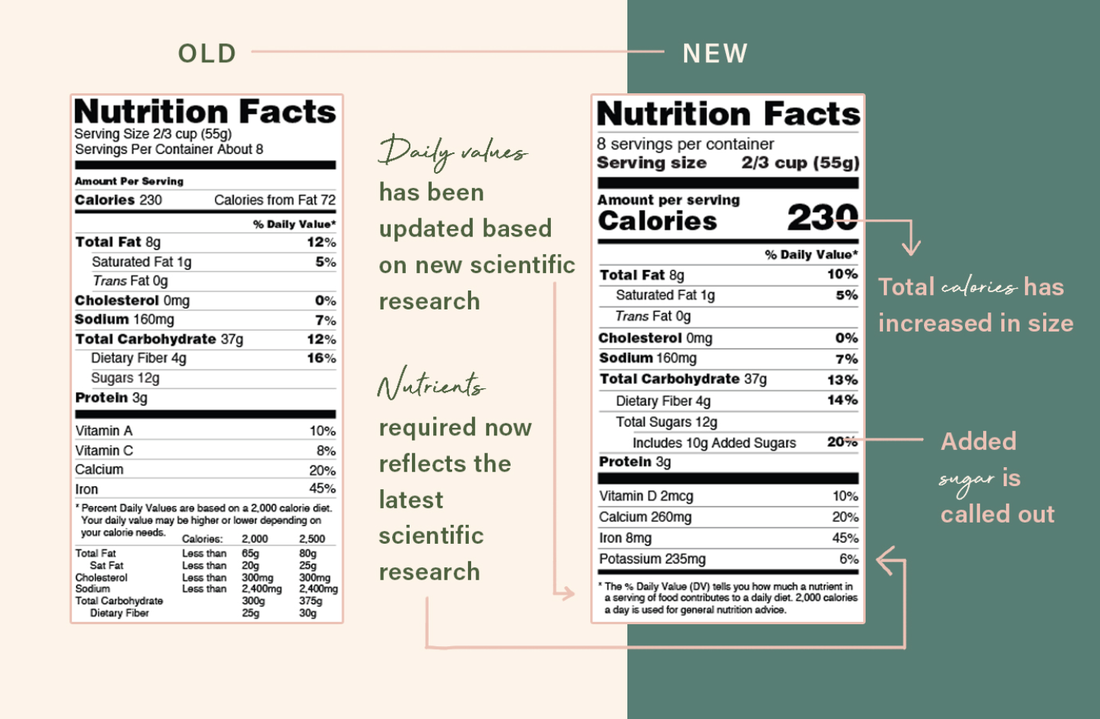|
Most of us are pretty familiar with what a nutrition label looks like, at this point. But now, you’ll notice that it looks a bit different, thanks to a requirement from the Food and Drug Administration three years ago that is finally going into effect. As of January 1, 2020, all food and (non-alcoholic) drink manufacturers with $10 million or more in annual sales are required to have nutrition panels reflecting the new changes. (Manufacturers with less than $10 million in annual food sales have until January 1, 2021 to comply.) I, for one, am excited to see these changes roll-out! Here are the 5 major changes: The five major changes to the nutrition facts and supplement facts label
Major Change 1 : Highlight of Serving Size. This change reflects a better understanding of how people consume certain foods. By law, serving sizes must be based on what people typically eat, not how much they should eat. An example is ice cream: Previous labels indicated a single serving size of 1/2 cup, but now the serving size is 2/3 cup. It’s recommended that you view this single serving size as a guideline for the maximum amount you would eat of that food. Again, it’s based on typical habits – not nutritional guidelines. Major Change 2 : Highlight of Calories. This change is meant to provide more context for where your daily calories are coming from and how many calories you’re consuming in a typical serving. It’s recommended to also consider other values on the label, such as fat, protein, fiber, and vitamins and minerals, because 300 calories of whole, unprocessed nuts is nutritionally different than a 300-calorie candy bar. Major Change 3 : Added Sugar is Called Out. It’s recommended that you keep your added sugar consumption to less than 10% of your total daily calories. However, sugar has become prolific in our food supply, and not just in what we consider junk food. Yogurt, bread, salad dressings, sauces, and protein bars can contain added sugars, and as consumers, we need to be more aware of how much sugar we’re eating. This includes learning how to read food labels for different sugar names – did you know there are over 60?! Beware, though: Many food and beverage products can use sugar substitutes, which do not need to be included on “Added sugars” line on the nutrition facts label. That’s why recognizing all the different terms for sugar is so important. Major Change 4 : Updates to Vitamin, Mineral, and Fat Information. Vitamins A and C are no longer required to be on the nutrition facts label but can be added at the manufacturer’s discretion. In turn, vitamin D and potassium are now required because research has demonstrated that many Americans do not get their required daily amounts of these nutrients. Vitamin D is not only important for bone health but also for keeping your immune system healthy and functioning. Potassium is essential for maintaining cellular function by contributing to fluid and electrolyte balance. It’s important to note that while these vitamins and minerals are present on the label (and in the food), they might have been added during processing – check the ingredients list on the package to confirm. It’s recommended that you get your vitamins and minerals from whole, unprocessed foods, such as fruits, vegetables, legumes, and whole grains. As for fat content, total fat, saturated fat, and trans fat amounts are still included, but calories from fat has been removed due to research indicating that the type and amount of fat is more important than how many calories are from fat. Major Change 5 : Updates to Daily Value Amounts. The daily value percentages have been adjusted based on research that demonstrates how certain foods and their nutrient makeup fit into the typical 2,000-calorie diet. The footnote description of what this percentage means has also been updated to better help people understand how their food choices fit into their daily diets.
0 Comments
Leave a Reply. |
HealthstyledHealth | Habits | Hormones Categories
All
Archives
April 2023
|


 RSS Feed
RSS Feed